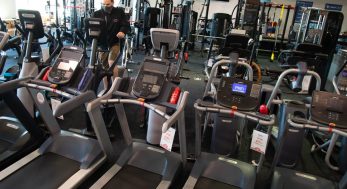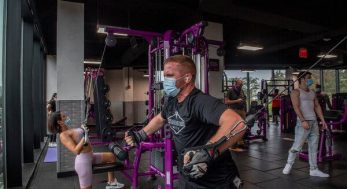A strong grip is crucial for lots of reasons. In sports like football, rugby, and martial arts, the ability to grab, hold, and control an opponent is vital. In activities such as rock climbing, your grip can literally be the difference between life and death.
In the gym, a strong grip means a better workout. All pulling exercises rely on a strong grip, and if your grip fails before the muscles you are working, your training will be less productive.
Imagine trying to pull a heavy deadlift, but your hands aren’t strong enough to hold the weight. Your grip will fail before your back, glutes, and hamstrings. The same is true for pulldowns, pull-ups, and rows. A weak grip could prevent you from building muscle.
A strong grip is also closely associated with longevity. A strong grip suggests that the rest of your body is strong too. Increased grip strength is closely related to good health (1). Strong hands are also less likely to suffer things like carpal tunnel syndrome and other conditions of the hand and wrist.
Finally, training your grip will add size to your forearms. The muscles that affect your grip originate in your lower arm, and big, powerful-looking forearms can add a lot to your physique. Even if your biceps are covered by your t-shirt sleeves, your forearms will be on show. Of all the muscles in your body, your forearms are probably visible the most often. If you care about how you look, don’t neglect your lower arm training.
Grip Anatomy
There are 20 muscles in the forearm (2), many of which affect your grip. Broadly speaking, these muscles can be divided into two groups – extensors and flexors. The extensor group open your hands and extend your wrist backward, while the flexors close your hands and curl your wrist downwards. The extensors are located on the top of your forearm while the flexors are beneath.
You don’t need to know the names of each individual grip and forearm muscle, but it is useful to know that there are muscles that flex your wrist and muscles that extend your wrist.
Just as you should train your biceps and triceps equally, you should also try and train your forearm flexors and extensors equally, too. This will create muscular balance, improve functionality, and could also reduce your risk of injury.

Grip training guidelines
Get the most from your grip training by following these rules:
Use chalk– dry hands mean you are free to concentrate on whatever exercise you are doing, and not how slippery your fingers feel. Use chalk to keep your hands dry. If your gym does not allow chalk use, make sure you dry your hands on a towel between sets.
Don’t use lifting straps– lifting straps boost your grip, but they don’t strengthen your hands. They address the symptom of a weak grip without fixing the cause. Try not to use lifting straps except at the end of your workout when your hands are exhausted. Do not use them for any grip training exercises.
Don’t use gloves– weight training gloves increase friction, which enhances grip. They don’t, however, increase hand strength. Try not to use gloves for strength training. Instead, look after your hands, filing down any calluses that you acquire. If you really want to wear lifting gloves, make sure you take them off when you do grip training exercises.
Don’t forget your finger extensors– strengthen the muscles that open your hands as well as those that close them. Wrap a rubber band around your fingers and open your hand against the resistance offered to strengthen your finger extensors too.
Stretch– make sure you include hand and forearm stretching exercises in your cool down, especially after grip training. For an easy forearm stretch:
- Place the palms of your hands together in front of your chest.
- With your palms touching, lift your elbows and push your hands down toward the floor.
- You should feel a deep stretch in your forearms and wrists.
- Hold for 30-60 seconds and then relax.
Training frequency– train your grip twice a week, either after your back and biceps workouts, or a couple of days afterward. Choose 2-3 exercises and do them for a month, and then change to keep your training interesting and productive.
Eight exercises for a stronger grip
Use these exercises to increase grip strength and build your forearms.
1-Plate pinch
Many feats of grip strength are easier if you have big hands or long fingers. This is NOT one of them!
- Place two equally sized weight plates together and squeeze them between your thumb and fingers.
- Pick them up and hold them by your side.
- Pinch them together as hard as you can, and for as long as you can.
- Put them down before you drop them on your toes.
2-Hex dumbbell hold
If your gym has hex-shaped dumbbells, you have access to one of the best grip-building exercises around.
- Stand a hex dumbbell upright and grab it by the end using your fingertips only.
- Pick it up and hold it for as long as you can.
- If you can manage more than 30-40 seconds, choose a heavier weight. The bigger the dumbbell, both in terms of weight and size, the harder the exercise will be.
3- Farmer’s walk
This is a real test and developer of grip strength. The farmer’s walk will build functional grip strength and also beef up your traps. Combine this exercise with number two for a real cast-iron grip builder.
- Lift and hold a heavy dumbbell in each hand.
- With your arms straight and down by your sides, take a walk around your training area.
- Walk as far as you can, putting the weights down just before your grip fails.
- Add some core work by using just one weight at a time.

4- Dead hang
This simple exercise increases grip strength and endurance. It also provides a good stretch for your lats and shoulders, while decompressing your spine. Do it at the end of your deadlift or squat workout.
- Grab and hold an overhead bar with an overhand, shoulder-width grip.
- With straight arms, lift your feet off the floor and hang for as long as possible.

5- Deadlift hold
Many exercisers report that their grip is the weak link in their deadlift – especially when doing high rep sets. Fix that problem with this deadlift-specific grip strengthening exercise.
- Place a bar in a power rack at just above knee height.
- Load it up with plenty of weight – approaching or even exceeding your one-repetition maximum.
- Grab the bar with your usual deadlift grip and then lift it clear of the pins.
- Hold the weight up for as long as you can. Put it down just before your grip fails.
- Make this exercise harder by using a double overhand grip.
6- Thick bar training
Standard thickness barbells and dumbbells allow you to overlap your fingers, creating friction and a stronger grip. The larger diameter of thick bars means less finger overlap, less friction, and more demand on your grip.
Good thick bar grip exercises include:
- Curls
- Rows
- Chins
- Pull-downs
- Deadlifts
If you don’t have access to thick bars, you can buy special removable grips that can be used to convert regular barbells and dumbbells into thick bars. Alternatively, you can wrap a towel around the bar to make it temporarily thicker.
7- Wrist curls
This traditional bodybuilding exercise is also a great grip builder. Make it even more demanding by using a thick barbell.
- Sit on the end of an exercise bench.
- Hold your barbell with an underhand, narrow grip.
- Rest your forearms and wrists on the bench, so your hands hang off the end.
- Extend your wrists and lower the weight down toward the floor. Allow your hands to open so the bar can roll down your fingers.
- Next, close your hands and curl your wrists upward. This works your wrist flexors.
To work your wrist extensors, turn your hands over and do this exercise with a palms-down grip. This exercise is called reverse wrist curls.
8- Towel pull-ups
Towel pull-ups work your back, biceps, and grip all at the same time. This is an excellent exercise for climbers, wrestlers, or anyone else who needs to build stronger hands and arms.
- Loop two towels over a pull-up bar and grip them tightly.
- Hang with your arms straight, and then do your pull-ups as normal.
- Do as many reps as you can, stopping your set just before your grip fails.
Can’t do towel pull-ups? Build your grip strength with towel dead hangs instead.
Conclusion
Hand strength is a highly desirable fitness quality. Some people have naturally strong hands, but grip strength is also very trainable. If you want a stronger grip and bigger forearms, you need to commit to training your hands just as you would any other muscle group, making it a priority in the coming weeks and months.
References:
1- PubMed: Grip Strength as an Indicator of Health-Related Quality of Life in Old Age https://www.ncbi.nlm.nih.gov/pmc/articles/PMC5750866/
2- PubMed:Anatomy, Shoulder and Upper Limb, Forearm Muscles https://www.ncbi.nlm.nih.gov/books/NBK536975/
Tags: grip strength

